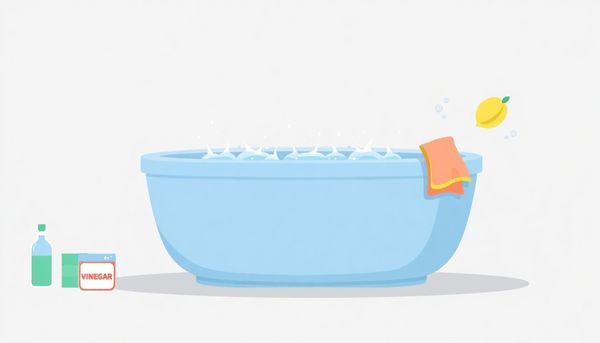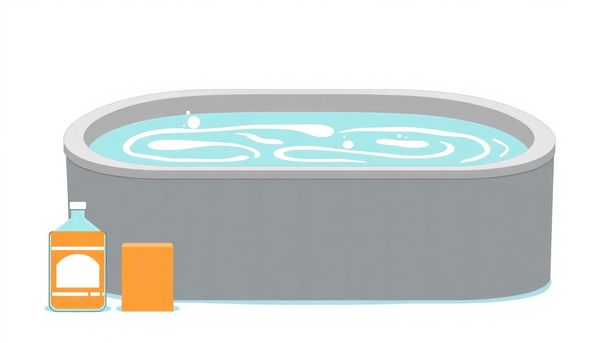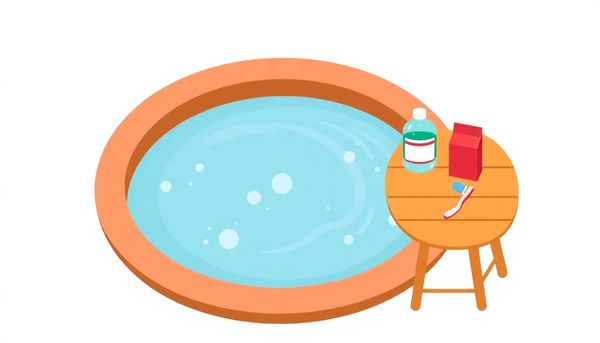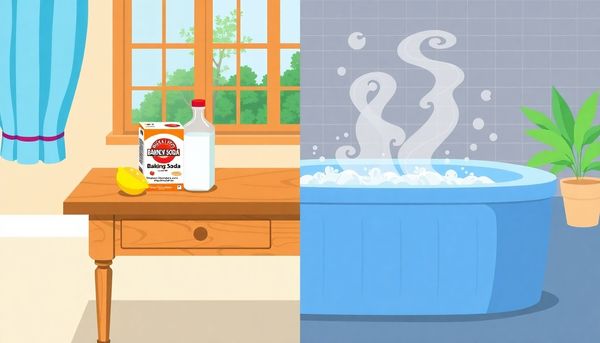Clean Your Hot Tub with Everyday Household Items
April 14th, 2024
April 14th, 2024
Steam rises gently from the surface, a warm invitation to unwind after a long day. Your hot tub is a haven of relaxation, but to keep it that way, regular cleaning is essential. Surprisingly, you might already have many of the tools needed to maintain its pristine condition right in your home. These everyday products can do more than just collect dust under the sink—they can keep your hot tub sparkling and fresh.
Consider baking soda, often used to tame the contents of your fridge. This versatile powder also tackles grime and neutralizes odors in your hot tub. White vinegar, another common household staple, pairs well with baking soda, creating a fizzing reaction that clears away stubborn deposits. Meanwhile, dish soap, known for its grease-fighting prowess in the kitchen, can also gently cleanse your tub's surface without harsh chemicals.
Each of these products plays a role in maintaining your hot tub, ensuring it remains inviting and hygienic. My own experience with these simple solutions came about last winter. I had guests coming over, and my usual cleaning supplies were out of stock. A quick rummage through my cabinets saved the day, turning a potential disaster into a triumph of resourcefulness.
With the right approach, maintaining your hot tub needn't be a chore. It becomes a manageable and even satisfying task when you realize that the secret to cleanliness lies within arm's reach.

Unravel the mystery of effective cleaning with simple ingredients you probably already own. Delving into your pantry might reveal the secret weapon against grime: white vinegar. Known for its acidic nature, vinegar is a powerhouse when it comes to dissolving stubborn residue, particularly on hot tub shells. Its ability to charge particles allows them to be easily washed away, keeping your tub pristine without the harshness of commercial cleaners. Just be sure it doesn’t venture into the pipe cleaning territory—biofilm needs a more specialized approach.
Complementing vinegar's might is the ever-versatile olive oil. This isn’t just a culinary staple; olive oil works wonders in breaking down greasy stains. It may sound counterintuitive to use oil to battle oil, but it effectively loosens sticky residues like sap from your hot tub cover. Finish the job with a protective coating to prevent future buildup, giving you more time to enjoy and less time scrubbing.
Baking soda, too, is a champion in this natural cleaning ensemble. With its gentle abrasiveness, it tackles persistent scum without scratching surfaces. Mix it with a touch of water to form a paste that buffs away grime, leaving your hot tub sparkling.
Harnessing these natural solutions not only keeps your tub clean but ensures safety for your family and pets, sparing them from exposure to toxic chemicals. Embrace these eco-friendly methods, and transform your cleaning routine into a sustainable practice, making every soak in your hot tub a truly refreshing experience.
Who knew that a treasure trove of cleaning solutions could be hiding right in your pantry? Forget about loading up on expensive, specialized hot tub cleaners when you already have everything you need at home. White vinegar, a staple in most kitchens, doubles as a powerful natural cleaner. With an acidity level that efficiently tackles grime without harming surfaces, it's perfect for removing those stubborn scum lines from your hot tub shell. Simply apply a solution of half vinegar and half water with a sponge, and watch the magic unfold.
Olive oil might not be your first thought for cleaning, but it works wonders on sticky residues. Imagine finding a sticky sap stain; a bit of olive oil can help loosen this gunky grip. Once the sap is softened, it wipes away easily, saving you the headache of scrubbing for hours.
And don't overlook the humble baking soda, a versatile ally that can clean and polish. When mixed with water, it forms a gentle abrasive paste that can conquer even the most determined grime. Sprinkle some on a damp cloth or sponge, and friction does the rest, leaving your hot tub gleaming without the fear of scratches.
These pantry essentials not only clean effectively but also reduce your exposure to harsh chemicals, making your hot tub experience safer and more enjoyable for everyone. So next time you’re in cleaning mode, take a detour to your kitchen—you might just find the perfect solution waiting in your cabinet.
A bottle of white vinegar might just be your hot tub's best friend. Nestled among spices and oils, it's a robust cleaner that tackles grime without the harshness of commercial products. The magic lies in its acidity, typically around 2.5 to 4 pH, making it strong enough to break down stubborn messes like scum lines on your hot tub shell yet gentle enough not to damage delicate surfaces.
One morning, I decided to try vinegar on my hot tub after noticing an unsightly ring of grime. Armed with a vinegar-water solution (equal parts of each), a soft cloth, and a bit of elbow grease, I was amazed at how effortlessly the scum melted away. Not only did the shell gleam, but I felt good knowing I wasn't leaving behind any harmful residues.
For an even deeper clean, filters can be soaked in a 50% vinegar solution for a couple of hours. This natural method can tackle moderate build-up, giving filters a new lease on life. However, if they're particularly grimy, a dedicated hot tub filter cleaner might be necessary.
A word of caution: while vinegar excels in many areas, it’s not effective for cleaning hot tub pipes. To tackle biofilm in the plumbing, stick with a line flush product. Embrace the power of vinegar for a chemical-free, cost-effective clean, and enjoy the peace of mind that comes with using something both effective and environmentally friendly.
When faced with the dilemma of sap stains clinging stubbornly to your hot tub cover, olive oil might not be the first solution that springs to mind. Yet, this kitchen staple doubles as a natural cleanser due to its emollient properties. Stubborn sap, acting like glue with its oily film, meets its match in olive oil, which can dissolve and lift the sticky residue without harsh scrubbing.
Think of a lazy Sunday afternoon when you’re about to host a hot tub party, and you notice those pesky stains marring the pristine surface of your tub. Instead of rushing to a store for specialized cleaners, a quick detour to your pantry for some olive oil can save the day. Just dab a bit on a soft cloth and gently rub the area. The oil acts by breaking the bond between the surface and the sap, allowing you to wipe it away effortlessly.
But olive oil's talents don’t stop at cleaning. Once the sap is gone, consider applying a surface protectant to prevent future messes. This not only maintains your tub’s shine but also minimizes the effort required for subsequent clean-ups. Over time, integrating olive oil into your cleaning routine can both conserve your elbow grease and keep your hot tub looking its best. After all, a well-maintained hot tub promises endless hours of relaxation and enjoyment.

When standing before your hot tub, the last thing you might expect is that your kitchen pantry holds the key to its cleanliness. Yet, those everyday household products, often overlooked, are powerful allies in maintaining your hot tub. White vinegar, for instance, is a staple in many homes. With its natural acidity, it's adept at dissolving grime without harsh chemicals. A simple swipe with a vinegar-soaked cloth can erase stubborn scum lines on your hot tub shell while leaving the surface undamaged.
Olive oil, commonly associated with culinary arts, transforms into a practical cleaner when faced with sticky sap stains on your hot tub cover. Its oily nature breaks down other oils, helping to detach dirt from surfaces. After using olive oil, consider applying a surface protectant to ward off future stains, saving you from repeat scrubbing.
Another underestimated powerhouse is baking soda, that tiny box tucked away for baking emergencies. When mixed with water, it becomes either a gentle scrub or a base cleaner, depending on your needs. Its mild abrasive qualities make short work of tough spots without scratching surfaces.
For those chrome or stainless steel fixtures that accumulate fingerprints faster than you'd like, rubbing alcohol is your best friend. A few swipes can restore their gleam, making your hot tub look brand new.
By utilizing these household products, not only will you maintain a sparkling clean hot tub, but you’ll also sidestep the cost and chemicals of specialized cleaners. It's a win-win for your wallet and well-being.
When it comes to sprucing up your hot tub, the solution might be closer than you think—in your kitchen cabinets. Forget those pricey, chemical-laden spa cleaners. Everyday household items like white vinegar and baking soda can work wonders. White vinegar, for instance, is not just for salads. This sharp-smelling liquid, with its 2.5-4 pH level, is a master at dissolving grime without harming your vinyl hot tub cover. If you've ever tackled a coffee maker clean-up, you know how effective vinegar can be.
Let's not overlook baking soda. This unassuming powder is a scrubbing dynamo. Sprinkle some onto a damp sponge, and it transforms into a gentle abrasive, perfect for tackling stubborn scum lines. Plus, its alkaline nature can adjust your tub's water chemistry, offering a dual benefit of cleaning and balancing.
Even olive oil, usually reserved for Mediterranean dishes, has a place in your cleaning routine. Got sticky sap on your hot tub cover? Olive oil can dissolve it thanks to its triglycerides, providing a natural alternative to harsher detergents. Simply apply a small amount to a cloth, rub the area, and watch the goo vanish.
Next time you're tempted to splash out on specialized cleaners, take a peek in your kitchen first. These natural solutions are not only effective but also kinder to both your wallet and the environment. Who knew a spotless hot tub could be just a pantry raid away?
Discovering hidden uses for everyday items can feel like unlocking a treasure chest of possibilities. Let's talk about natural cleaning solutions that double as mighty warriors in the battle against hot tub grime. A stroll through your kitchen might reveal a few unsuspecting champions eager to clean without the harshness of industrial chemicals.
White vinegar, for instance, is a fantastic cleaner sitting quietly in most pantries. Its acidic nature makes it excellent for dissolving stubborn deposits lining your hot tub shell. Remember the last time you tackled those pesky scum lines? Next time, try vinegar instead of pricey commercial products. Its cleaning prowess lies in its ability to charge and dismantle particles, making them a breeze to rinse away. However, steer clear of using it for the pipes—vinegar lacks the strength to combat that pesky biofilm.
Olive oil might seem like an unusual choice, but its natural properties can help remove sticky residues like sap from your hot tub cover. Acting as a detergent, it breaks down oils that trap dirt, leaving surfaces clean without damaging them. Once you've tackled the mess, protect the surface with a reliable protectant to prevent future stains and UV damage.
And then there's baking soda, that versatile powder often overlooked. A bit of it on a damp sponge transforms into a gentle abrasive, perfect for scrubbing stubborn spots. Each of these natural cleaners offers a safe, effective way to maintain your hot tub’s sparkle while keeping your home environment friendly.
Among the treasures hidden in your kitchen pantry, there’s one that stands out for hot tub maintenance: vinegar. This household staple, known for its culinary uses, offers surprising prowess as a cleaning agent. Imagine the last time you tackled limescale in your kettle with vinegar; it works just as effectively on those stubborn soap scum lines clinging to your hot tub’s interior.
The secret lies in vinegar’s acidity, generally around 2.5 to 4 pH. This mild yet effective level of acidity allows it to break down grime without harming the surfaces of your hot tub. I remember once dragging a chair into my bathroom to tackle mineral deposits on the showerhead. A vinegar soak transformed it, and I realized this method could extend to my hot tub maintenance as well. Simply mix equal parts vinegar and water in a spray bottle, mist the solution over the tub's surface, and let it sit for a few minutes before wiping with a soft cloth.
But don't stop at the surface. Your hot tub filters can also benefit from a vinegar bath. Submerge them in a 50/50 mix of water and vinegar for a couple of hours. This gentle approach dissolves mineral buildup, extending the life of the filter. However, if the filter is extraordinarily grimy, it might be time for a dedicated filter cleaner or a replacement. While vinegar falls short in cleaning the internal plumbing of your hot tub, its versatility makes it indispensable for maintaining the tub’s gleam. Embrace this natural cleaner, and you’ll find your hot tub sparkling and inviting, ready for the next relaxing soak.

Hot tubs, often seen as a luxury, can be surprisingly easy to maintain with items you might already have at home. Take white vinegar, for instance. While it might typically feature in your salad dressings, it's a surprisingly effective cleaning agent for a hot tub. Its acidity, generally around 2.5pH, works wonders on scum lines, dissolving residue without damaging delicate surfaces such as vinyl covers. A simple vinegar solution can also rejuvenate your filters; soaking them in a half-vinegar, half-water mix can breathe fresh life into them, though particularly grimy filters might need a stronger cleaner.
Then there's olive oil, an unexpected hero in the fight against sticky messes. It acts in a similar way to traditional detergents, breaking down stubborn sap stains or oil films that might cling to your tub’s shell. A light rub with olive oil can loosen deposits, making them easier to wipe away. Just be sure to follow up with a surface protectant to reinforce the clean.
And don't overlook baking soda, your reliable household companion. Known for its mild abrasive properties, it's perfect for tackling more resistant scum without scratching surfaces. Simply sprinkle a little on a damp sponge and watch it work its magic, scrubbing away dirt with minimal effort.
These everyday items not only clean effectively but also offer peace of mind by avoiding the introduction of harsh chemicals into your home spa environment. Plus, they save you a trip to the store and a hit to your wallet, leaving you more time to enjoy those soothing bubbles.
Vinegar might be the unsung hero of your kitchen, but it also moonlights as a fantastic hot tub cleaner. When I first discovered its versatility, I was skeptical, much like when a friend insists you try a bizarre food combination. However, after seeing its effectiveness, it quickly became a staple in my cleaning routine.
White vinegar, easy on the pocket and tough on grime, boasts an acidity level of around 2.5 to 4 pH. This mild acidity is perfect for dissolving stubborn residues without damaging the vinyl or acrylic surfaces of your hot tub. Armed with a soft cloth and some diluted vinegar, you can effortlessly tackle those pesky scum lines that form along the water's edge. Just a gentle scrub, and they vanish, leaving your tub sparkling and inviting.
A word to the wise: while vinegar excels at surface cleaning, don't be tempted to pour it down the pipes. It’s not your best bet for tackling the biofilm that lurks within. Stick to a hot tub line flush product for that task to ensure your pipes remain free of buildup.
Beyond just cleaning the shell, vinegar can also revive your filters. Immerse them in a mixture of equal parts water and vinegar for a couple of hours. This soak can help loosen debris and mineral deposits. Nevertheless, for truly stubborn grime, occasionally investing in a dedicated filter cleaner might be the way to go.
Using vinegar not only keeps harmful chemicals at bay but also ensures your spa moments are as relaxing and worry-free as they should be.
Olive oil might not be the first thing that comes to mind when considering hot tub maintenance, but this versatile kitchen staple offers some surprising cleaning benefits. While many are familiar with the culinary uses of olive oil, its role as a gentle yet effective cleaner is often overlooked. A smear of olive oil can work wonders on stubborn sap stains or sticky residue that cling to the shell or cover of your hot tub. These stains are often accompanied by an oily film that traps dirt, making their removal a challenge. Here, olive oil steps in as a natural detergent, breaking down these greasy bonds and allowing for easier cleanup.
Consider the time a friend of mine was battling a persistent sap spot on her hot tub cover. She swore by olive oil, applying a small amount directly onto the stain and gently rubbing it in with a soft cloth. The sap lifted with ease, and afterward, she applied a surface protectant to guard against future mishaps.
Beyond its cleaning prowess, olive oil also offers eco-friendly credentials. Unlike harsh chemical cleaners, it's biodegradable and less likely to irritate sensitive skin—perfect for households with curious kids or pets. Plus, many soaps, especially those on the natural aisle, harness olive oil's triglyceride content, making it a greener alternative to traditional cleaning agents. So, next time your hot tub needs a little TLC, reach for that bottle of olive oil in your pantry.
Finding that perfect solution to remove stubborn stains from your hot tub can sometimes feel like a never-ending quest. Yet, one unassuming hero often sits quietly in your pantry: baking soda. This humble powder not only raises the alkalinity of the water but also shines as a versatile cleaner for a myriad of surfaces.
Remember the last time you scrubbed the kitchen sink and marveled at how it sparkled after a simple baking soda treatment? The same principle applies to your hot tub. Begin by making a paste of baking soda and water. Dab it onto a sponge and target those pesky scum lines or any stubborn spots that refuse to budge. The gentle abrasiveness of baking soda means it’s tough on stains but kind to your hot tub’s surface.
One weekend, I noticed some unsightly rings around the hot tub after a long summer of frequent use. Out of cleaning supplies, I turned to my trusty box of baking soda. With a little patience and some elbow grease, the rings vanished, leaving the surface looking as good as new. Not only did it clean effectively, but it left no harsh chemical residue, ensuring a safe soak for the family.
In integrating baking soda into your cleaning routine, you’ll not only maintain a sparkling hot tub but also embrace a natural, eco-friendly cleaning approach. It’s an affordable and efficient solution, perfect for those mindful of both their budget and the environment.

Cleaning a hot tub doesn't have to be a chemical-laden chore. By embracing green-cleaning practices, you can maintain your spa while being kind to the environment and safe for your family. There’s a certain satisfaction in using everyday items to achieve sparkling results, especially when those items are already sitting in your pantry.
Consider white vinegar, for instance. This humble liquid is a powerhouse, easily cutting through stubborn scum lines on your hot tub’s shell. Its natural acidity dissolves grime without harming surfaces, a perfect alternative to harsh chemicals. I remember the first time I tried vinegar on my hot tub; the gleaming results were a revelation, and my wallet breathed a sigh of relief at the savings.
Baking soda, another kitchen staple, doubles as a gentle abrasive. Mix it with a little water to form a paste, and it becomes your ally against persistent stains. The mild scrubbing action cleans without scratching, keeping your tub’s finish intact. I’ve even used it on my bathroom tiles, and the results never disappoint.
Olive oil, unexpected in cleaning realms, works wonders on sticky residues like sap. Its ability to break down oils is ideal for removing unwanted spots without resorting to synthetic detergents. And when I discovered that olive oil could be used beyond the kitchen, it was like finding a secret weapon in my cleaning arsenal.
Green-cleaning your hot tub not only protects your investment but also safeguards your loved ones from toxic exposure. It’s a win-win approach, paving the way for eco-friendly spa relaxation.
When it comes to cleaning your hot tub, reaching for non-toxic cleaners is not just a trend; it's a mindful choice that resonates with households aiming for health and sustainability. You might be surprised to find that your pantry holds ample solutions that are both effective and gentle. Take vinegar, for instance. Its acidic nature helps dissolve grime and scum without the harshness of industrial chemicals. A simple vinegar and water mix can tackle those stubborn water lines, and it won’t leave you worrying about harmful residues lingering on surfaces where children or pets might touch.
Baking soda, too, is a fantastic ally in your quest for a sparkling hot tub. When mixed with water, it forms a mild abrasive that can scrub away the most persistent stains. Unlike commercial products laden with unpronounceable chemicals, baking soda offers peace of mind with every scrub—it's safe enough to use on various surfaces without risking damage. Plus, it's an eco-friendly option that won't hurt the environment when rinsing it away.
For a good measure, consider the power of olive oil. This isn't just for cooking anymore; olive oil can break down sap stains and sticky residues, acting as a natural detergent. These simple, non-toxic solutions prove that maintaining a clean hot tub doesn’t require a trip to the store for specialty products. With a few pantry staples, you can keep your soaking space pristine and safe, ensuring every dip is refreshing and worry-free.
A hot tub may seem like a luxury that requires specialized care, but the secrets to maintaining its shine could be nestled right within your kitchen pantry. White vinegar, a staple in many households, doubles as a powerful cleaner for your hot tub surfaces. Its moderate acidity effectively tackles stubborn scum lines without the harshness of industrial cleaners. One evening, I spent an hour scrubbing my tub with diluted vinegar, and not only did it sparkle, but I felt a tad smug for not having to spend extra on fancy cleaners. Just be wary of using it in the plumbing, as it won't tackle biofilm lurking in the pipes.
Then, there’s baking soda, known for its versatility beyond the kitchen. When combined with a little water, baking soda forms a gentle abrasive paste perfect for targeting persistent grime. One lazy Saturday afternoon, I realized the baking soda I'd used to deodorize the fridge was the unsung hero my hot tub needed. Mixing it with water and giving the shell a good scrub lifted grime like magic. It also helps maintain your water’s pH balance—bonus!
And don’t underestimate the humble olive oil. Once, I faced a sticky sap mark that refused to budge, but a dab of olive oil did the trick, breaking down the sticky residue without harming the tub's surface. While these pantry essentials might not have a catchy jingle, they offer a wallet-friendly, eco-conscious alternative for keeping your hot tub pristine.
Stepping into the world of hot tub maintenance might initially seem daunting, yet with the right guidance, it becomes a breeze. One key aspect often overlooked is the protection of your hot tub surfaces. A well-guarded surface not only extends the lifespan of your tub but also elevates your soaking experience.
While many turn to commercial products, household staples like vinegar and olive oil can work wonders. Vinegar, for instance, acts as a natural hero in mitigating scum lines and grime. Its gentle acidity, hovering around a 2.5 to 4 pH, makes it perfect for surfaces prone to wear, like vinyl covers. A simple wipe-down with diluted vinegar can prevent buildup without the harshness of commercial cleaners. No need to rush to the store when your pantry has the solution.
On the other hand, olive oil isn’t just for cooking. It doubles as a gentle cleanser and protector for your hot tub's surface. By applying a small amount after cleaning, you create a barrier that repels future stains. This not only saves time but also keeps your tub looking pristine for those spontaneous late-night soaks.
Remember, consistent care with these natural alternatives will keep your hot tub's surfaces intact and inviting. It's all about finding harmony between effective cleaning and gentle protection, ensuring that your sanctuary remains a place of relaxation and joy.

Who would have thought the path to a spotless hot tub could begin in your own kitchen pantry? You might have gingerly approached your bubbling oasis, wary of the grime and stains that cling stubbornly to its surfaces. Yet, armed with a few pantry staples, you can conquer those blemishes without the need for industrial-strength cleaners.
Consider the potent pairing of simple baking soda and lemon juice. While baking soda's mild abrasive nature makes it perfect for scrubbing, lemon juice lends its natural acidity to break down grime. A smudge of lemon juice on a soft cloth, sprinkled with a touch of baking soda, can effectively lift those stubborn dirt marks on your hot tub shell. The blend not only cleans but leaves behind a fresh, citrusy scent that's far more pleasant than chemical fragrances.
Then there’s the often-overlooked power of salt. Mixed into a paste with a bit of water, salt can serve as a gentle abrasive to tackle mildew or stubborn stains. Rub it on, let it sit for a few minutes, and then scrub away with a non-scratch sponge. Rinse thoroughly, and your surfaces will gleam.
Incorporating pantry staples into your cleaning routine isn't just about convenience or savings—though those are excellent perks. It's about finding effective, eco-friendly solutions that bring peace of mind, knowing you’ve avoided harsh, potentially harmful chemicals. So next time you're faced with a cleaning conundrum, look no further than your kitchen for a natural, effective answer.
No need to scour the aisles for pricey products when you can raid your pantry for a cleaning marvel: vinegar. This isn't just an ordinary splash for salads; it's a powerhouse for banishing the stubborn scum that clings to your hot tub. My own journey with vinegar began out of sheer curiosity one lazy Sunday afternoon. Spotty watermarks and mysterious rings around my tub became no match for this household hero, and I was thrilled to discover the magic of vinegar firsthand.
Vinegar, with its acidity level typically hovering around 2.5 to 4 pH, breaks down the grime without the harshness of commercial cleaners. Its power lies in the way it charges particles, making them easier to wipe away. To tackle those pesky scum lines, simply grab a sponge or cloth, dab it in undiluted white vinegar, and give the affected areas a good scrub. The transformation is almost immediate, leaving you with a gleaming surface at a fraction of the usual cost.
And here's another tip: vinegar isn't just for the tub itself. Extend its prowess to your filters; a soak in a 50/50 vinegar and water solution for a couple of hours can rejuvenate them. However, don't fret if your filter's seen better days—sometimes replacement is the only answer. Embrace this natural, effective, and economical approach to hot tub maintenance, and let vinegar do the work while you save your energy for more relaxing pursuits.

This article provided insights into maintaining your pool. Start your pool care journey today!
Want to become a pool maintenance expert? Our free Pool School course covers everything you need to know about pool care. From basic maintenance to advanced troubleshooting, you'll learn how to:
Join over 10,000 pool owners who have already transformed their pool care routine. Get started with our free Pool School course today!